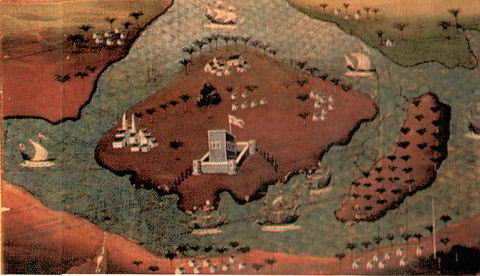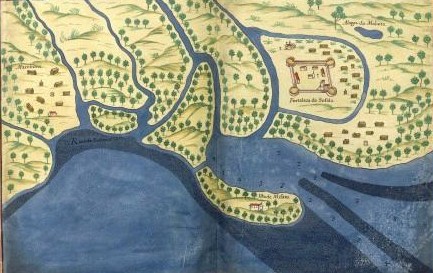
To next page
Note on Sofala
Sofala, is a Mozambique seaport on the east coast of Africa, at the mouth of a river of the same name. The town possesses scarcely a trace of its former importance, and what trade it had was nearly all taken away by the establishment of Beira a little to the north in 1890.
Sofala harbor is silting up and is obstructed by a bar. Ruins exist of the strong fort built by the Portuguese in the 16th century. The Cathedral of Largo do Munica Apio is found on Av. Eduardo Mondlane. The cathedral was erected in 1925 and is partially built of stone from the sixteenth century Fort of Sofala which has since been flooded beneath the sea.
Previous to its conquest by the Portuguese in 1505 Sofala was the chief town of a wealthy Moslem state, Arabs having established themselves there in the 12th century or earlier. At one time it formed part of the sultanate of Kilwa.
The wealth of the town depended on trade in ivory and other goods, but the most important commodity was gold. Gold was mined in the area of present day Zimbabwe and taken to the coast at Sofala (present-day Beira), from which it was shipped up the coast via Kilwa. There was also an overland route from Kilwa to Lake Nyasa and the Zambezi but this was always secondary to the sea routes. Sometime in the thirteenth century the sultans of Kilwa seem to have gained direct control of Sofala. They lost the control shortly before the coming of the Portuguese.
Inland the gold mining was in the hands of various kingdoms, the oldest was:
The city-state of Mapungubwe, located on the southern banks of the Limpopo River, rose during the tenth century after establishing control over the gold trade. With the demise of Mapungubwe power shifted south to the Great Zimbabwe. Scholars speculate that the founders of the Great Zimbabwe Kingdom owed their wealth to control of the twelfth-century trade in gold from the Save River valley. Skeletons have been discovered at the bottom of narrow, ancient mining shafts in the region. At the peak of the trade, an estimated 1000 kg of gold passed through Great Zimbabwe annually. The port cities of Sofala and later Kilwa flourished from the commerce. After Great Zimbabwe collapsed around 1450, a succession of gold-trading dynasties originated in the region of present-day Zimbabwe and Mozambique, beginning with Mutapa and Torwa in the fifteenth century, and followed by Rozwi in the seventeenth century.
The city and harbour before the Portuguese
----------------------------------------------------
At Sofala there were two villages: one close to the sea, on a sand flat forming the north-eastern point, contained about four hundred inhabitants; the other, a couple of miles higher up the bank of the estuary, also contained about four hundred residents. The sheik lived in the last named. His dwelling house was constructed of poles planted in the ground, between which wattles were woven and then plastered with clay. It was thatched, and contained several apartments, one of considerable size, which could be used as a hall of state. The floor, like that of Bantu huts, was made of ant heaps moistened and stamped. It was covered with mats, and the room occupied by the sheik was hung with silk, but was poorly furnished according to modern European ideas. This was the grandest dwelling house in Africa south of the Zambezi, indeed the only one of its size and form, in the first year of the sixteenth century.

